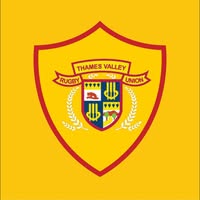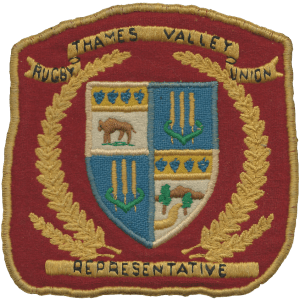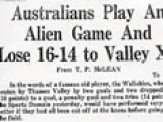

Thames Valley Rugby Football Union was formed in 1922. The large South Auckland Rugby Union, which covered the Goldfields, Waikato and King Country areas ran into difficulties in 1921 as constituent unions were seeking to break away and gain full union status from the New Zealand Rugby Union. Rugby in the Thames Valley Rugby Football Union’s area has been linked to those romantic pioneering days of the timber and mining industries of the 1870s. The game was played in Coromandel and Thames from 1870 with Auckland players travelling to Thames to play games. As the timber and mining spread south from Thames to Paeroa and the farming activities came east from Hamilton so did the game spread into the Thames Valley.
The first clubs outside Thames were Katikati and Waihou, based at Waitoa, in 1880. On the Coromandel Peninsula clubs affiliated with Auckland were Mercury Bay, Whitianga, Tairua in 1888 and a year later came another four clubs, three of them in Coromandel. The first club in Te Aroha was in 1883, Paeroa in 1886 and Waihi in 1895. While Thames and Coromandel country unions remained with Auckland, the Paeroa, Waihi and Piako (in 1930 renamed Te Aroha) unions formed the Ohinemuri Union in 1899, which was the fore-runner of the Thames Valley Rugby Union as we know the union today. By 1904 these three unions were joined by Karangahake union to establish the Goldfields Rugby Union. The founding unions and clubs were Paeroa (West, East Suburbs), Waihi (City, West Suburbs, Katikati) Karangahake (City Suburbs, West End, Waitekauri, Waikino) Piako (Te Aroha, Waihou, Manuwaru). In 1909 the Goldfields joined Waikato (Hamilton, Cambridge, Waipa), and next Rotorua, King Country, Maniapoto and Opotiki to form the South Auckland union. The next season, 1911, Rotorua and Opotiki withdrew to form the Bay of Plenty union.
The Ohinemuri Union was founded at Waihī in 1896, and by 1904 this union was named the Goldfields Rugby Union. It consisted of a number of even smaller unions, but was itself a sub-union of the Auckland Rugby Football Union (ARFU), and was therefore not directly affiliated to the New Zealand Rugby Union (NZRU). Along with a number of other sub-unions, the Goldfields ceded from the ARFU to form the South Auckland Rugby Football Union in 1909.
Several sub-unions split away from the South Auckland Union between 1909 and 1921 to form new independent unions, and in 1921 the Hauraki Plains, Paeroa, Piako, Waihī sub-unions did the same to form the Thames Valley Rugby Football Union (TVRFU). The union was from then on directly affiliated to the NZRU. The Thames Valley Union, which had remained affiliated to the ARFU up until then, joined the TVRFU in 1951.
After the First World War (1914-1918) and rugby came out of recess the South Auckland union was in trouble with first the Waikato withdrawing in 1920 to form the Waikato union, and at the end of the next season the King Country union was formed. At the start of the 1922 season the Goldfields underwent a name change to Thames Valley Rugby Football Union. The four inaugural sub-unions were Paeroa (West, Hikutaia, Suburbs, Netherton, Komata), Waihi (Katikati, City, Mataura, Waitete), Te Aroha (Te Aroha Rovers, Te Aroha Rambles, Manuwaru, Waihou Rangers) and Hauraki Plains which was formed in 1920 (Turua, Waitakaruru, Ngatea, Kerepehi and Patetonga). For the 1935 and 1936 seasons the Thames union joined the Valley but then returned to Auckland. Thames along with the Coromandel union joined Thames Valley in 1951. The Katikati club was given dispensation by the Valley union to play in the Bay of Plenty in 1965 and the boundary was changed in 2001. There have been approaches to extend the union’s boundaries into Morrinsville and Matamata but to no avail. The future of Thames Valley depends entirely on outside influences being generated by professionalism in rugby.
High points in Thames Valley rugby
Thames Valley played in a match unique in New Zealand rugby history in 1961. Lined up against them for Waikato that day were the five famous Clarke brothers: Brian, Don, Doug, Graeme and Ian.

Since its first challenge for the Ranfurly Shield in 1951, a 19–6 loss to North Auckland, Thames Valley has endured 14 further defeats in this quest. In 1980 the Swamp Foxes provided Waikato with a stiff challenge before going down 16–7 in the 400th Ranfurly Shield match. This remains their closest shield challenge. In 1986 the union suffered its heaviest ever defeat, a 97–0 mauling at the hands of Auckland.
Success on the domestic front has been confined to NPC third division titles in 1988, 1990 and 1995. Their greatest result came in 1962, when the visiting Australians were defeated 16–14 at Te Aroha.
Great players
One of the early stars of rugby in the Thames Valley region was Jack Dufty, who played for the Goldfield Union based in Thames, which was then a sub-union of Auckland. In Canterbury’s 1906 Ranfurly Shield challenge at Auckland’s Alexandra Park Dufty turned in a remarkable performance with the boot. Auckland’s convincing 29–6 victory included four conversions by Dufty, plus a penalty and a goal from a mark (a now obsolete means of scoring) taken inside his own half. Mick Lomas was another local player to star while Thames was still associated with Auckland, playing 15 times for the All Blacks in 1925–26.
Bob O’Dea (1953–54) and Kevin Barry (1962–64) remain the only Thames Valley players to have represented the All Blacks while playing for the union. Thames Valley captain O’Dea was a surprise selection as flanker for the 1953 All Blacks tour of Britain and France. His tour was hampered by a knee injury and he played in only five of the of the 36 matches. Though selected as a flanker he was considered to lack the necessary pace and was seen as a better prospect at lock because of his height.
Kevin Barry’s versatility won him a place in two All Black touring teams in the early 1960s. While primarily played as a loose forward, at 1.88 m (6 ft 2 in) tall and weighing nearly 100 kg he at times found himself at lock. In 1961 Barry followed in the footsteps of Jack Dufty by playing Ranfurly Shield rugby for Auckland. After returning to Paeroa for the 1962 season, he was selected for that year’s All Blacks tour of Australia and also made the team to Britain and France in 1963–64. The Barry family holds a special place in All Black history. Kevin’s father Ned was an All Black in 1932 and 1934, and in 1993 Kevin’s son Liam made his All Black debut on the tour of Scotland and England, giving the Barrys the unprecedented honour of having three generations of All Blacks.
In the smaller unions there are often players who provide years of service to their team without receiving national accolades. For Thames Valley, Brian Duggan with 144 games (1970–84) and David Harrison with 665 points (2004–14) stand out.
{Click on the year for more details}
|
|||||||||
| 1920 |
1921
|
1922
|
1923
|
1924
|
1925
|
1926
|
|||
|
1927
|
1928
|
1929
|
1930
|
1931
|
1932
|
1933
|
|||
|
1934
|
1935
|
1936
|
1937
|
1938
|
1939
|
1940
|
|||
|
Thames Valley did not play Representative Games between 1941 and 1944 owing to the
Second World War |
1945
|
1946
|
|||||||
|
1947
|
1948
|
1949
|
1950
|
1951
|
1952
|
1953
|
|||
|
1954
|
1955
|
1956
|
1957
|
1958
|
1959
|
1960
|
|||
|
1961
|
1962
|
1963
|
1964
|
1965
|
1966
|
1967
|
|||
|
1968
|
1969
|
1970
|
1971
|
1972 | 1973 | 1974 | |||
|
1975
|
1976
|
1977
|
1978
|
1979
|
1980
|
1981
|
|||
|
1982
|
1983
|
1984
|
1985 |
1986
|
1987
|
1988
|
|||
|
1989
|
1990
|
1991
|
1992
|
1993
|
1994
|
1995
|
|||
|
1996
|
1997
|
1998
|
1999
|
2000
|
2001
|
2002
|
|||
|
2003
|
2004
|
2005
|
2006
|
2007
|
2008
|
2009 | |||
|
2010
|
2011
|
2012
|
2013
|
2014
|
2015
|
2016
|
|||
| Union Records ( As at March 2023) | ||
| Highest Attendance |
7,000
|
Thames Valley v Auckland (Ranfurly Shield), 1989 |
| Most Appearances |
143
|
B.C. Duggan, 1970-84 |
| Most Points |
665
|
D.P. Harrison, 2004-15 |
| Most Tries |
42
|
I.F. Campbell, 1981-94 |
| Most Points in a Season |
130
|
T. Doolan, 2021 |
| Most Tries in a Season |
14
|
I.F. Campbell, 1988 |
| Most Conversions in a Season |
30
|
D.B. McCallum, 1995 |
| Most Penalties in a Season |
25
|
J.R. Reynolds, 2011 |
| Most Dropped Goals in a Season |
4
|
TE. Shaw, 1962 KW Kemp, 1968 |
| Most Points in a Match |
27
|
D.B. McCallum v East Coast, 1995 M. Griffin v King Country, 2003 |
| Most Tries in a Match |
4
|
I.F. Campbell v North Otago, 1990 |
| GA. Ellis v North Otago, 1994 | ||
| G. W. McLiver v Marlborough, 1995 | ||
| Most Conversions in a Match |
8
|
G.A. Ellis v West Coast, 1994 M.A. Handley v North Otago, 1994 |
| Most Penalty Goals in a Match |
7
|
D.P. Harrison v Mid Canterbury, 2009 J.R. Reynolds v East Coast, 2011 R.D. Crosland v Whanganui, 2019 |
| Highest Team Score |
86
|
v North Otago, 1994 |
| Record Victory (Points Ahead) |
79
|
86-7 v North Otago, 1994 |
| Highest Score Conceded |
113
|
v Northland, 1997 |
| Record Defeat (Points Behind) |
99
|
14-113 v Northland, 1997 |

